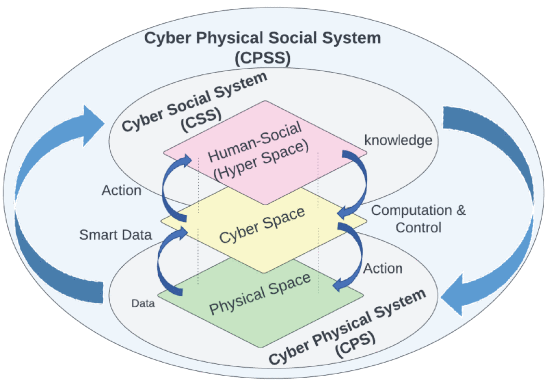1. Objective
This project involves the definition, modeling, and implementation of an agent-based model (ABM), also referred to as multi-agent-based simulation (MABS), for the simulation and analysis of a cyber-physical (social) system.
Cyber-physical systems (CPS) are engineered systems that are built from, and depend upon, the seamless integration of computation and physical components. Advances in CPS will enable capability, adaptability, scalability, resiliency, safety, security, and usability that will expand the horizons of these critical systems.
2023)
The CPSS tightly integrates data processing into physical systems, cyberspace, and the social world through heterogeneous resources, including sensors, actuators, and computational systems to form a unit in cyber environments. Furthermore, the configuration and computation in a CPSS aim to achieve superior Quality of Service (QoS), quality of experiment, and performance. Therefore, the multi-objective optimization of the CPSS operation strongly depends on trustworthy and efficient computation and communication among several layers of the three subsystems.
2022)

Domains of application include (but not limited to) agriculture, aeronautics, building design, civil infrastructure, energy, environmental quality, healthcare and personalized medicine, manufacturing, transportation, and smart cities.
2. Description
Students are required to choose an existing or propose a new cyber-physical (social) system, in any domain, for analyzing. The system must meet a set of minimum criteria:
-
Representation of physical components
-
Multiple agents responsible for controlling (making decisions) or interacting (directly or indirectly) with the physical components
-
Dynamic system (system change over time)
Once chosen the cyber-physical system, the students have to
-
implement the model as an agent-based model using the Repast Simphony;
-
describe the cyber-physical system and the respective simulation model in a report structured using the ODD+D protocol;
-
deliver a presentation highlighting the purpose, design, and experiments performed using the model.
You can find examples of systems described using ODD+D at Example ODD and a basic template at Reporting Structure.
3. References
-
Pasandideh, S., Pereira, P., & Gomes, L. (2022). Cyber-Physical-Social Systems: Taxonomy, Challenges, and Opportunities, IEEE Access. 10, pp. 42404-42419. doi: 10.1109/ACCESS.2022.3167441.
-
Wang, F. -Y. (2010). The Emergence of Intelligent Enterprises: From CPS to CPSS. IEEE Intelligent Systems. 25(4), pp. 85-88. doi: 10.1109/MIS.2010.104.
-
U.S. National Science Foundation (2023). Cyber-Physical Systems